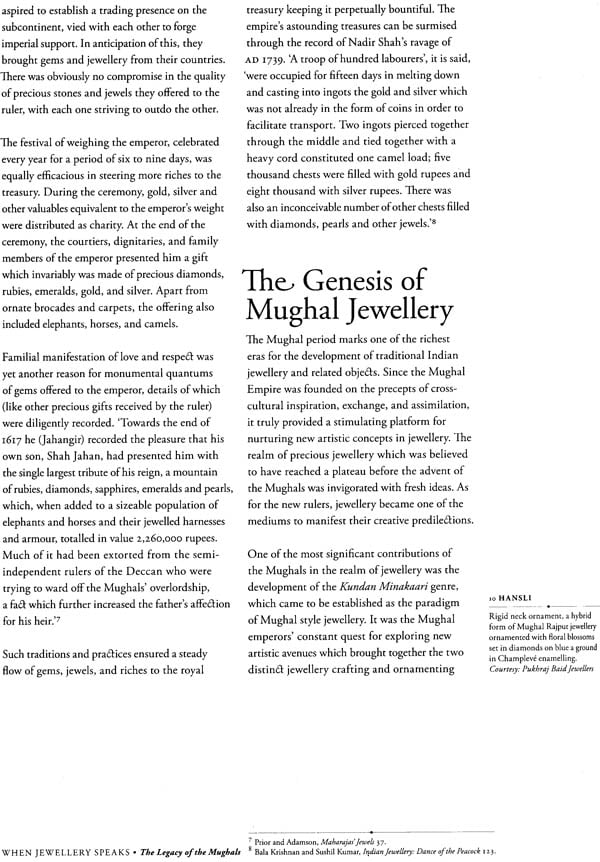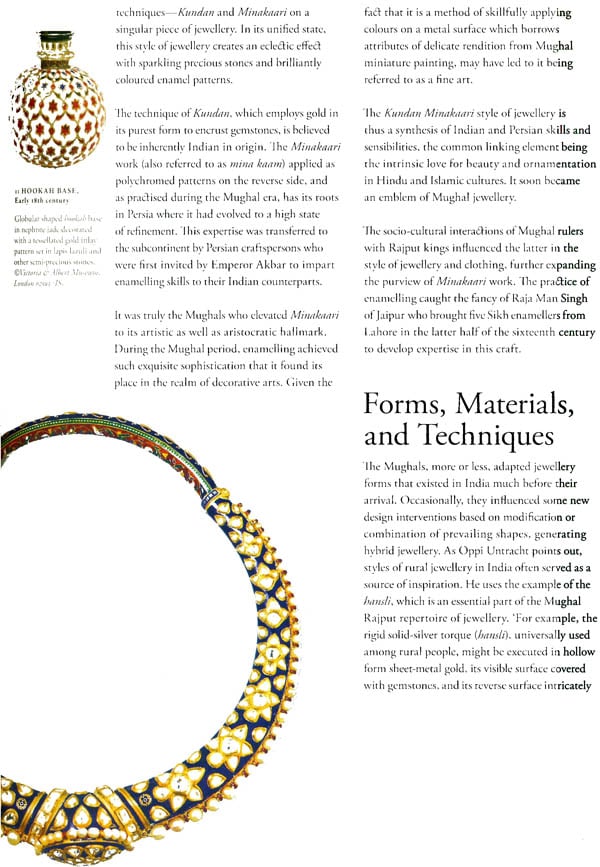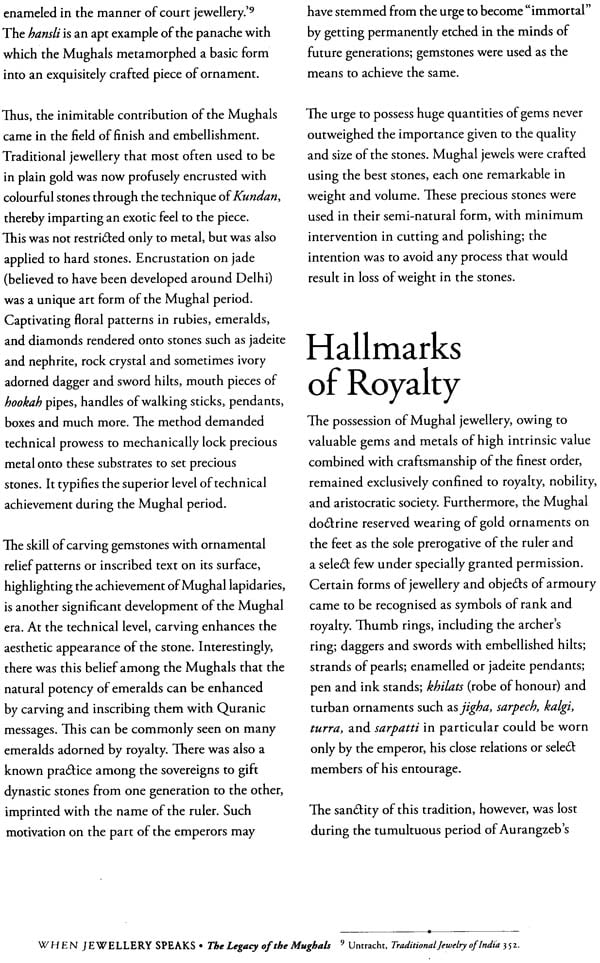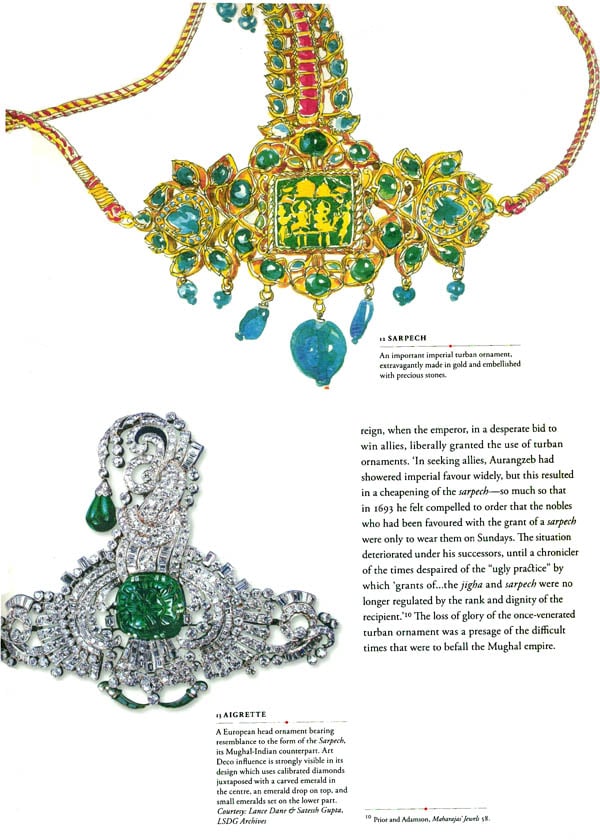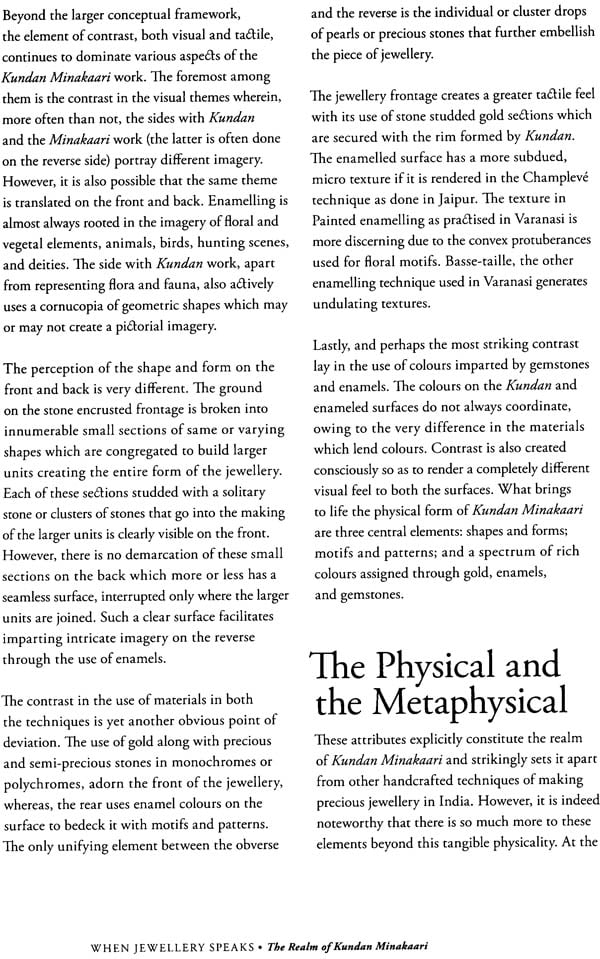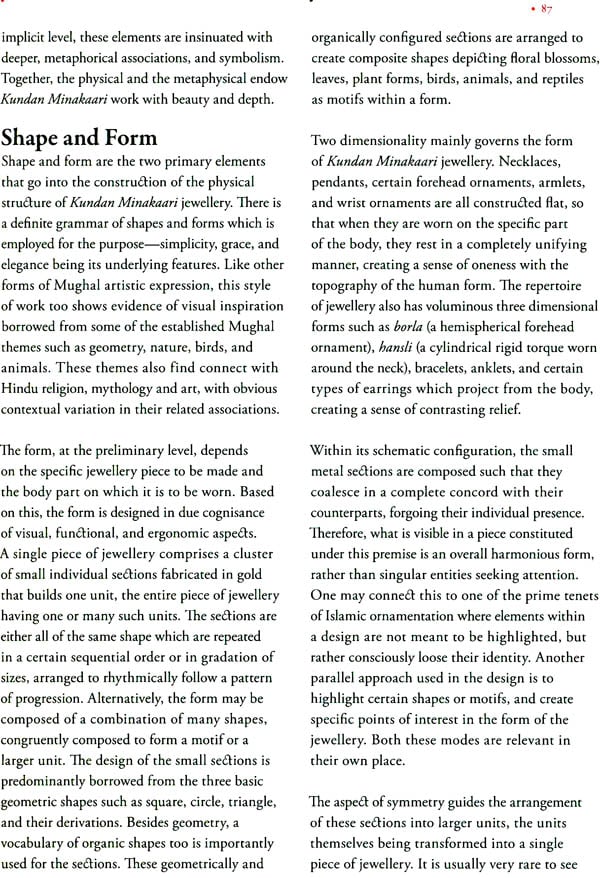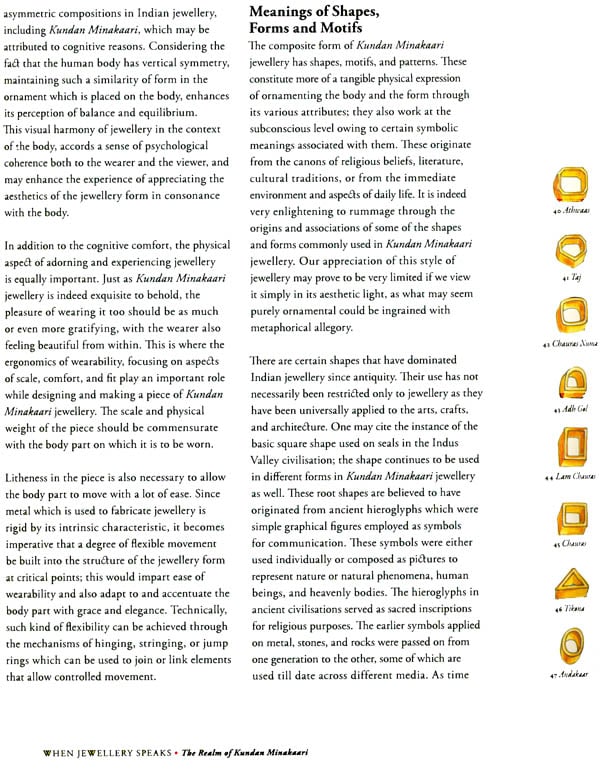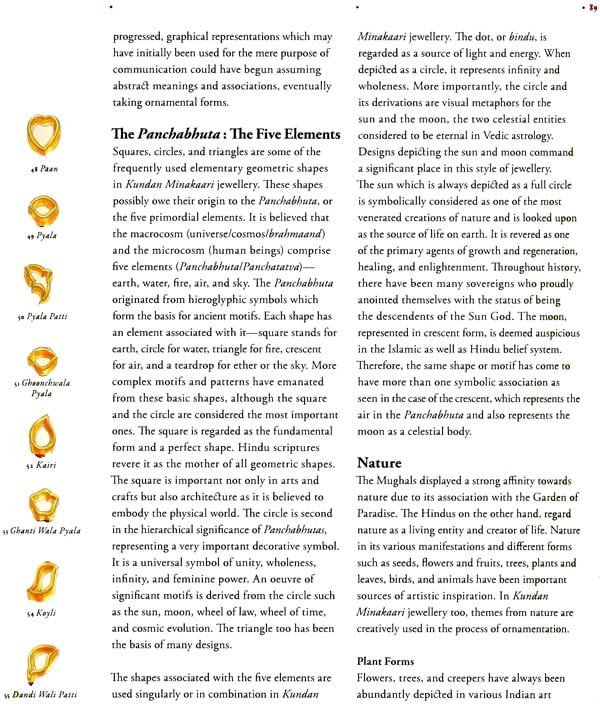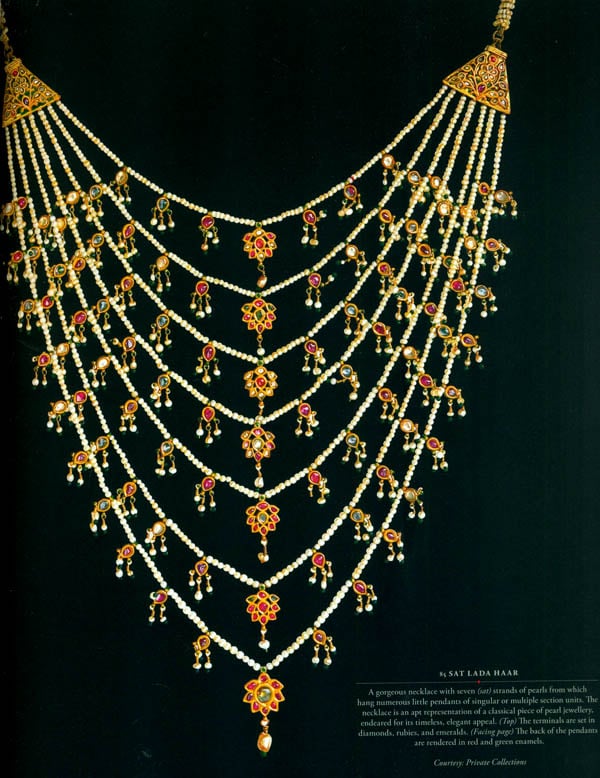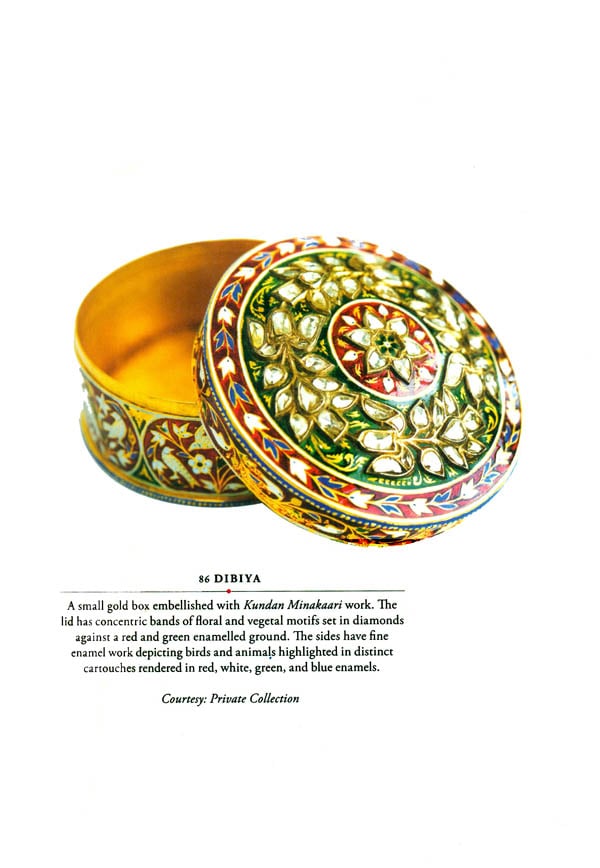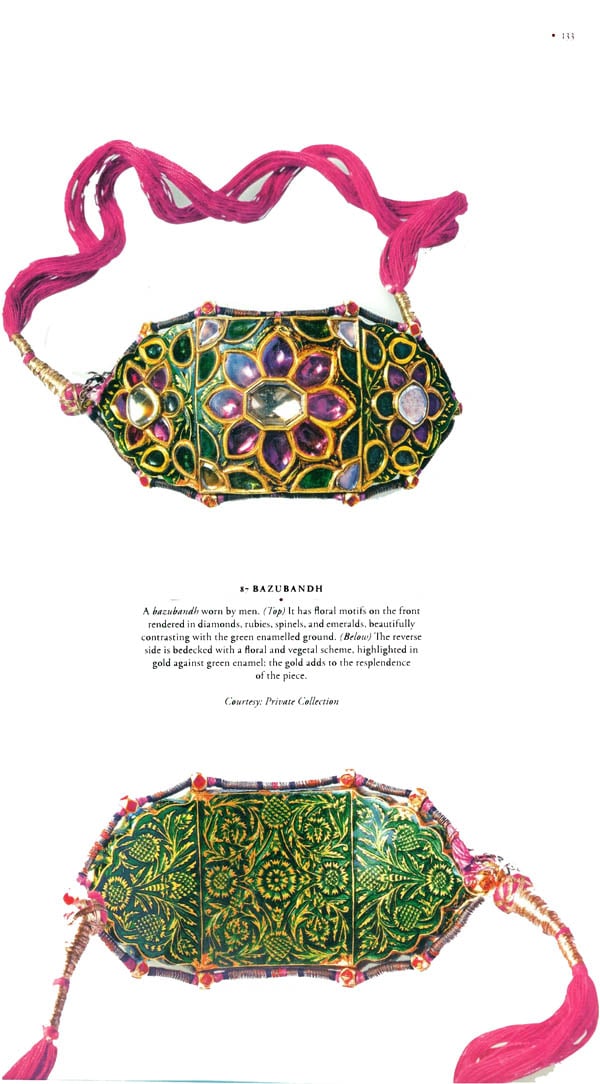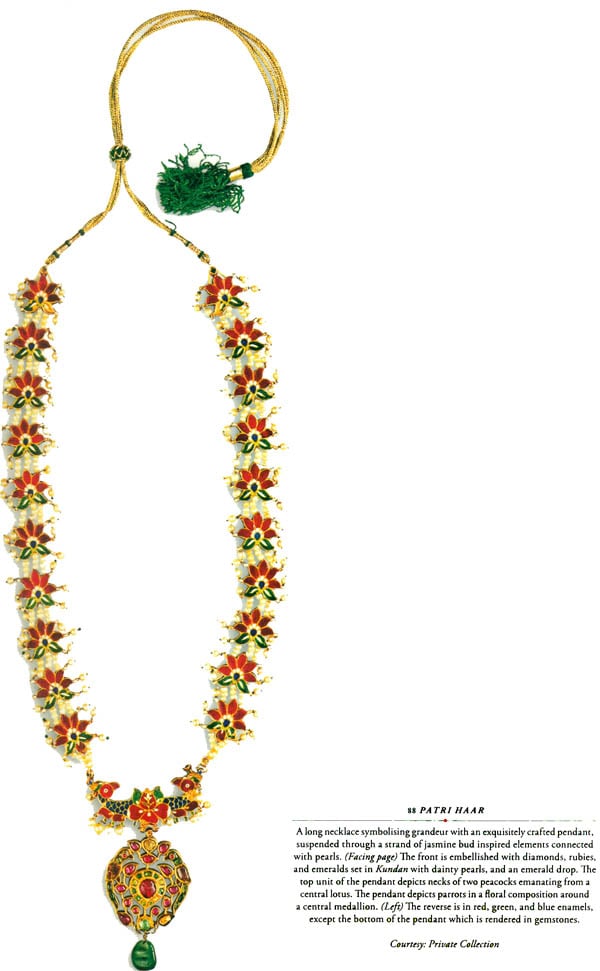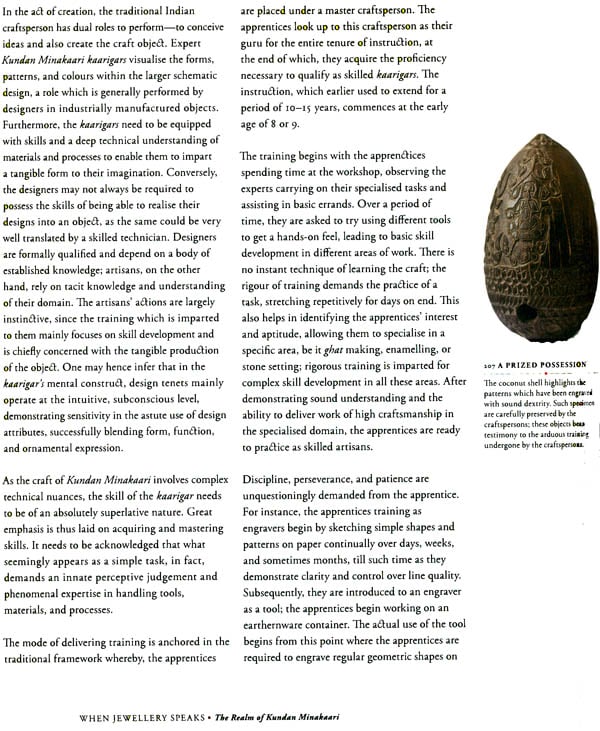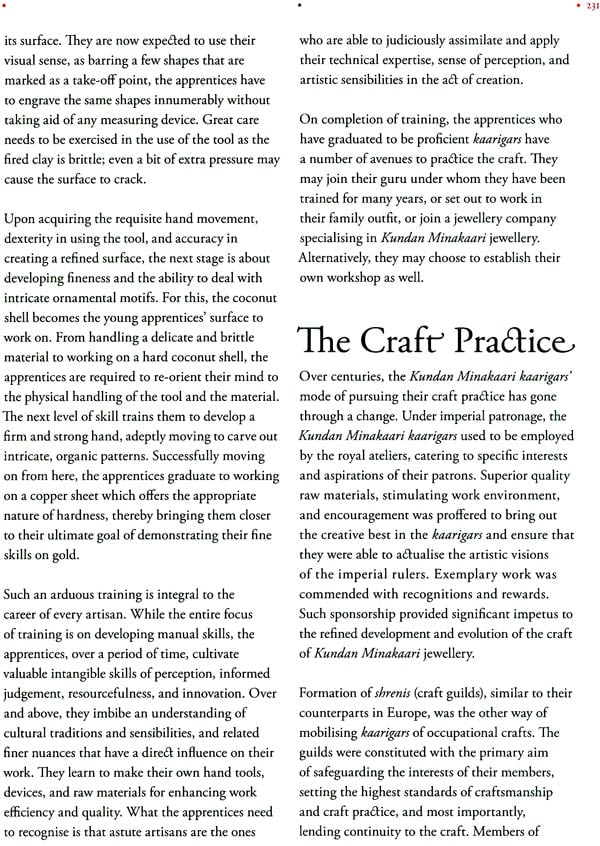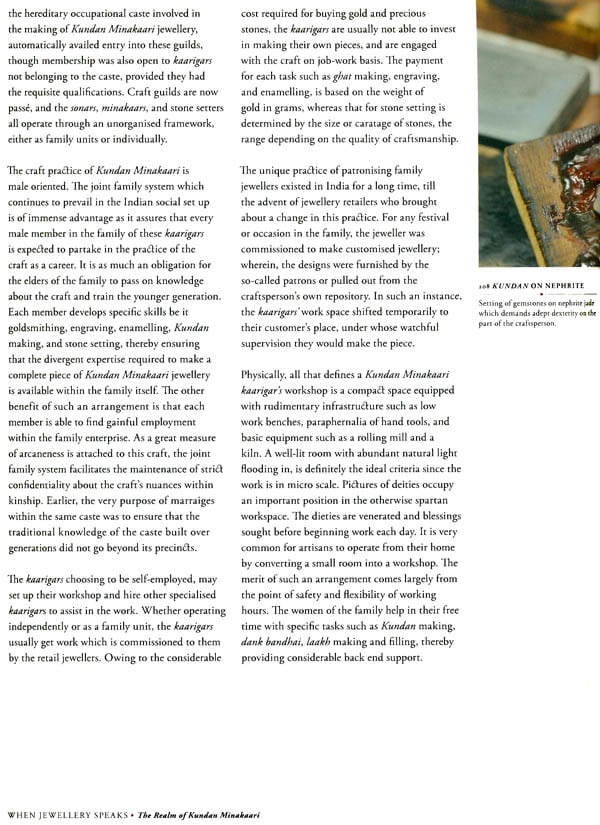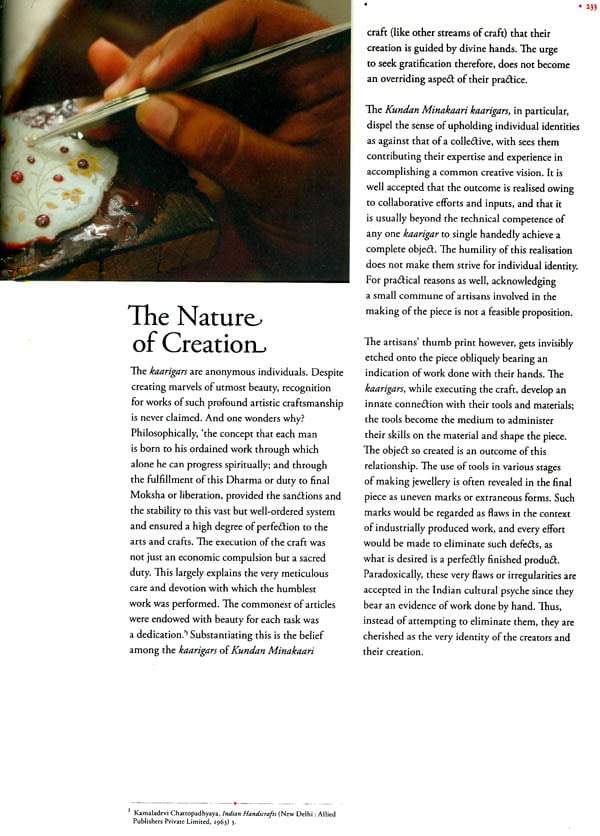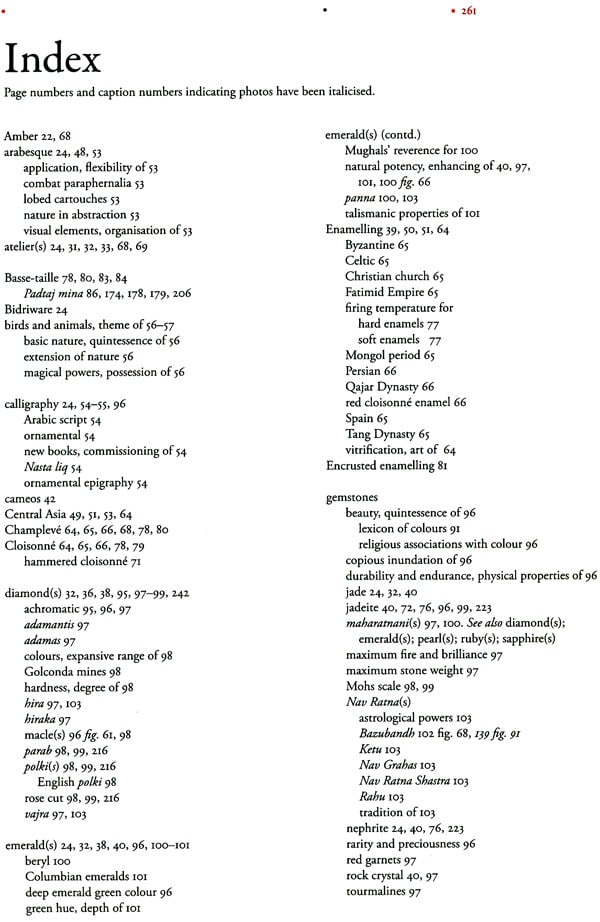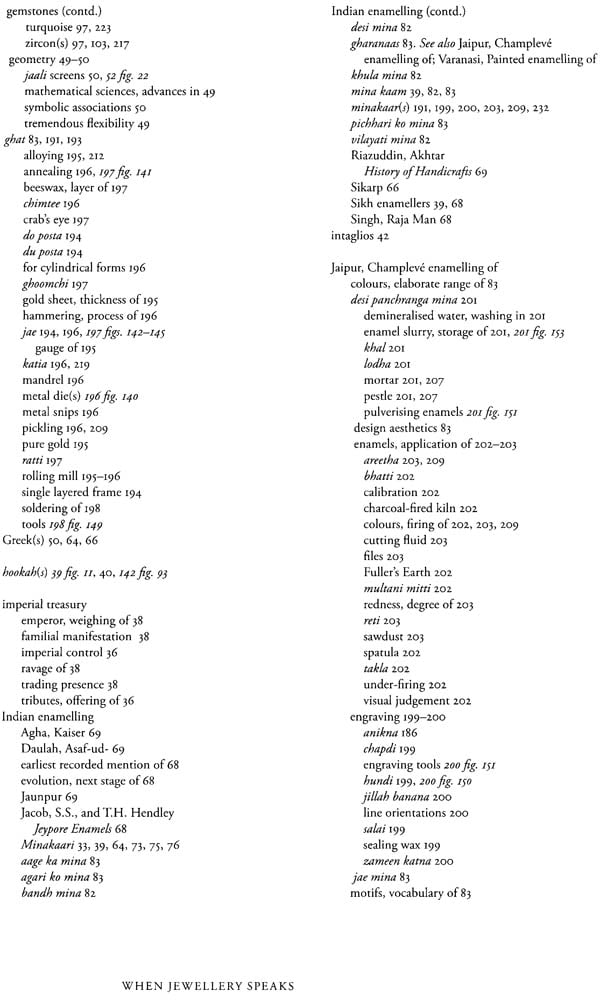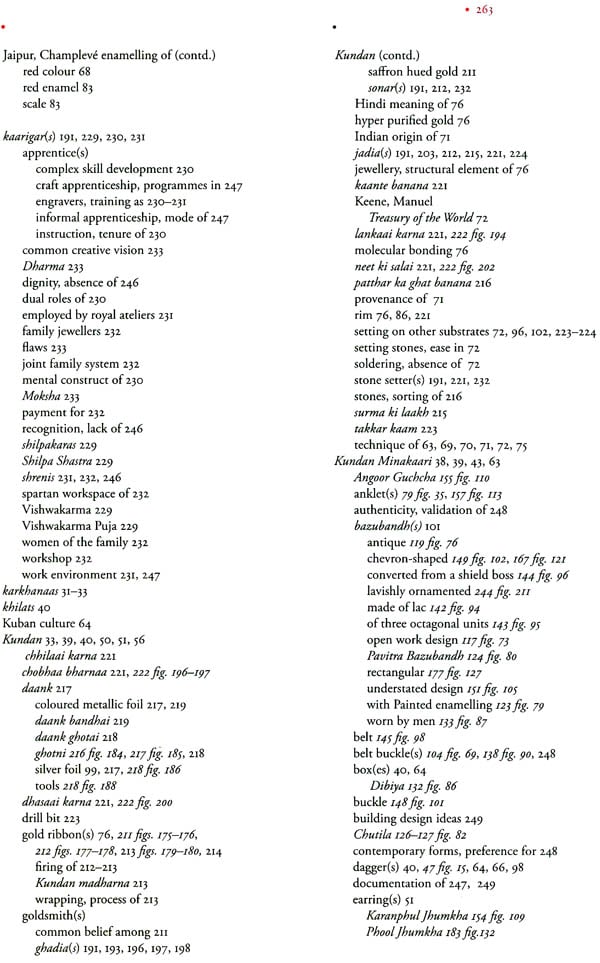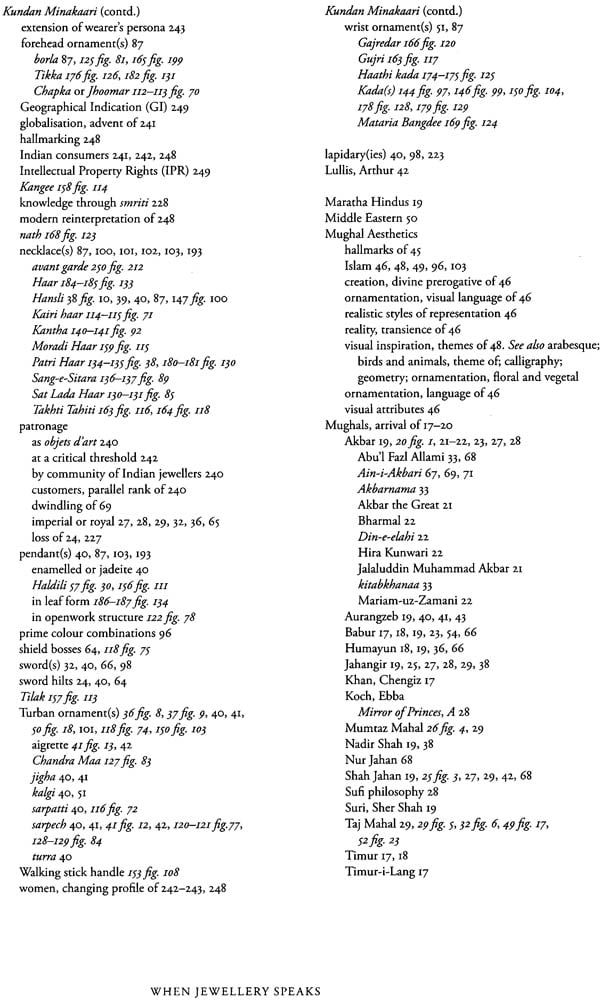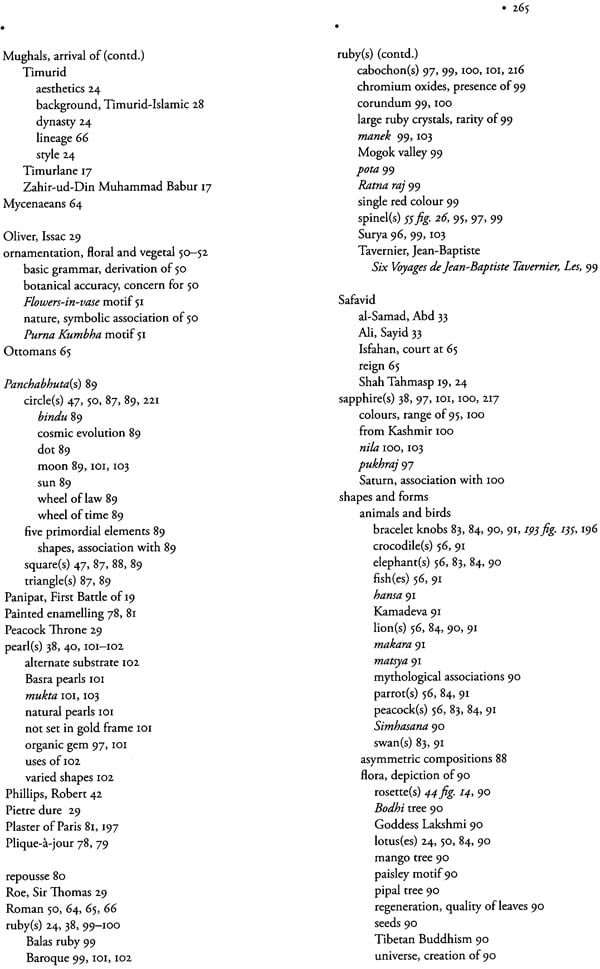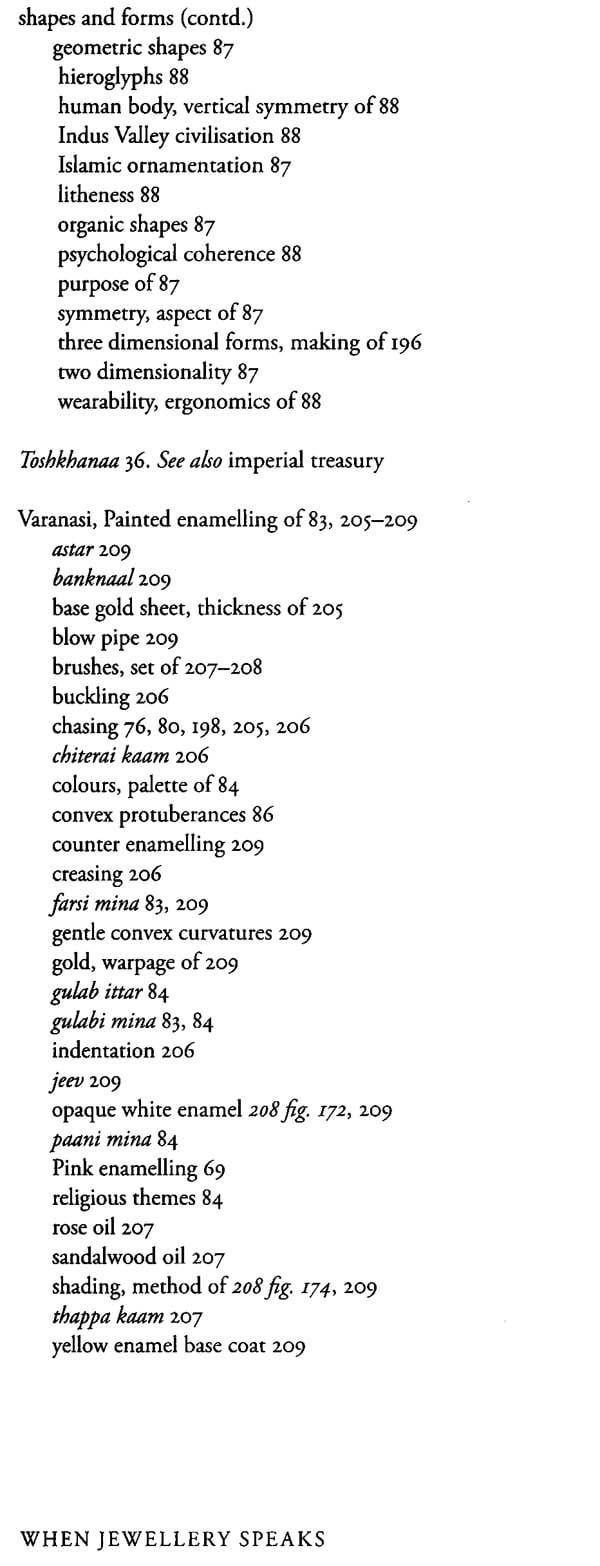
When Jewellery Speaks (Celebrating the Tradition of Kundan Minakaari)
Book Specification
| Item Code: | NAG569 |
| Author: | Shimul Mehta Vyas |
| Publisher: | National Institute of Design, Ahmedabad |
| Language: | English |
| Edition: | 2012 |
| ISBN: | 9788186199756 |
| Pages: | 267 (Throughout color Illustrations) |
| Cover: | Hardcover |
| Other Details | 12.5 inch X 9.5 inch |
| Weight | 1.80 kg |
Book Description
About the Book
When Jewellery Speaks provides a fascinating insight into the genre of Kundan Minakaari jewellery. Once a powerful symbol of regalia, this jewellery tradition continues to enjoy unbridled popularity even today. The book forms a veritable kaleidoscopic odyssey as the Kundan Minakaari tradition journeys through annals of history, comes alive with aesthetic grandeur, unravels layers of symbolism, describes the crafting process and techniques to every single detail, and highlights its socio-economic relevance in the context of its craftspersons, along with its contemporary appeal and future prospects. A visual celebration of exquisite pieces of jewellery and artefacts from India, combined with an absorbing corpus of facts, make this book a compelling read. All in all, what comes to the fore is the need to preserve and cherish the cornucopia of traditions that India possesses, the cultural legacy of Kundan Minakaari being an integral part of the same.
Foreword
India, which is known around the world for its heritage and royalty, never had the practice of documenting its traditions and indigenous art forms. Due to this, so many traditional techniques and art forms of India seem to have been lost over a passage of time.
From the excavations of Mohenjo Daro and Harappa to the crown of Elizabeth II, the queen of United Kingdom, Indians are known for their expertise in creating innumerable forms of jewellery which have fascinated the world, of which Kundan is one of the oldest form of jewellery made and worn in India and continues to be in vogue. Thanks to its patronage by the royalty during the Mughal era, it flourished and gradually became the jewellery of the masses when it was successfully mastered in Rajasthan, Varanasi, and Chennai. Kundan Minakaari jewellery is today synonymous with the state of Rajasthan, whose capital, Jaipur, has evolved as the main centre of this art form. The famous Johri Bazar of Jaipur is the nerve centre of this traditional craft, Nathdwara is renowned for silver work, and Bikaner is known for its Kundan Minakaari work.
Possibly no Indian wedding today is complete without Kundan Minakaari jewellery. The global fascination with Bollywood and elaborate Indian weddings, all highlight the popularity of Kundan Minakaari jewellery. The book is an ode to this wonderful art of jewellery making and documents how it has evolved over the ages as a signature art of India.
The gem and jewellery industry of India is grateful to Shimul Mehta Vyas, senior design faculty from the National Institute of Design (NID), who has put in a stellar effort in pursuing research and compiling this valuable document on Kundan Minakaari jewellery, which will not only prove to be an important reference material in future, but also turn the spotlight on the unique creative abilities of Indian craftspersons in the world of jewellery. The vision and dedication of the Jaipur Jewellery Show (JJS) towards inspiring and publishing this book is really commendable and the gem and jewellery industry will be indebted to it for this endeavour.
I, as the Chairman of the Gem and Jewellery Export Promotion Council (GJEPC), the apex body of jewellery trade and exports from India, proudly dedicate this book to the connoisseurs of Indian art and jewellery in the country and across the world. The book will help them understand and appreciate what we were and grasp what we can.
Introduction
Jewellery has been one of the important markers of the creative expression in the Indian socio-cultural milieu. As a country, India has been bestowed with a diversity of traditions-both rural and regal; an enormous repertoire of materials, processes, and techniques; and a vocabulary of imagery layered with deep rooted allegoric meanings and associations. Such is the richness of its context and the vastness of its visual grammar that Indian jewellery has always been a matter of great interest to historians, research scholars, academicians, and practitioners-all of whom have captured its various aspects. Seminal works which encompass the monumental spectrum of jewellery in the sub-continent existing in published form are being looked up as significant references.
When a plethora of resources are already available on the subject of Indian jewellery, the conception of a book that focuses exclusively on the craft of Kundan Minakaari and serves as a useful reference for the jewellery industry and its various stakeholders, calls for a careful contemplation. Much thought was needed to establish the core focus of the book, through which, its envisaged audience would find meaning and purpose. One line of thought was to address the detailed nuances of the process of making Kundan Minakaari jewellery which forms one of the fundamental aspects of this craft. However, this seemed to do limited justice to this genre because it is not merely the technique of crafting precious jewellery; it is indeed a style of ornamentation in itself. Thus, rather than viewing it from a narrow perspective, it was important to explore it as a genre of ornamentation and adornment which has dominated our socio-cultural landscape for almost five centuries.
As an author who was approaching the subject from the perspective of a design educator, it was imperative to discover and bring forth critical facets that have influenced the development of Kundan Minakaari as a unified craft technique and an aesthetic style bequeathed to us through a glorious past. Being true to the realm of design which draws knowledge and understanding from the disciplines of history, sociology, arts and crafts, material culture, and more-all of which help build a holistic perspective, the endeavour has been to deal with the subject from multiple standpoints. When Jewellery Speaks has emerged as an outcome of such an expedition; it is a piece of work entirely dedicated to the Kundan Minakaari jewellery crafting tradition. Simply stated, it is a pursuit for establishing a larger scenario around this classical style by revisiting its past, recording the present, and mapping its future prospects.
In an environment where many of our traditional crafts are endangered owing to the vagaries of changing times, the prime intent of the book has been to study, document, and disseminate valuable information about Kundan Minakaari. Equally critical is the necessity of preserving the knowledge about this jewellery tradition. It is hoped that a greater awareness would enable us to better comprehend its finer nuances and enhance our appreciation of this heritage craft.
This book takes the reader through a retrospective journey into the fabled Mughal period, during which, this genre of jewellery reached glorious heights of artistic expression. It accentuates the creative vision of the Mughal emperors which saw the coming together of two independent styles and techniques of jewellery-Kundan and Minakaari, on a single piece of jewellery or object. Furthermore, it presents an understanding of the grammar of the Mughal style which influenced the shaping of a whole new idiom of aesthetic sensibility applied across the legion of jewellery and other modes of creative articulation. Mughal aesthetics, largely influenced by Islam, is based on the tenet of a homogeneous language of ornamentation applied across arts, crafts and architecture. Five key features-geometty, floral and vegetal themes, calligraphy, arabesque, and forms of animals and birds constitute the foundation of its design vocabulary. Insights into the evolution of Kundan and Minakaari as individual techniques in their own standing through different periods and cultures, inform readers about the historic journey of the craft, particularly focusing on the remarkable Persian influence which contributed to the development of enamelling in India. Equally enlightening is the information about different enamelling techniques, their inherent characteristics, and methods of application.
The book focuses on the two main centres of enamelling in India-Jaipur and Bikaner in Rajasthan and Varanasi in Uttar Pradesh which practise the craft of Kundan Minakaari on gold jewellery and objects. Interestingly, both these centres specialise in two distinct techniques of enamelling with Champleve being the forte of Jaipur and Bikaner, and Varanasi excelling in Painted enamelling. It is this diversity of techniques and their related styles which impart great variety to the panorama of enamelling in India. An attempt has been made to articulate and build connections around the visual elements of shapes, motifs and patterns, and colours that dominate the visual design of Kundan Minakaari jewellery.
What forms the quintessence of the book is that it has endeavoured to present the little known stages integral to the process of making Kundan Minakaari jewellery. The sequential unfolding of the various steps involved in realising a single piece of jewellery, enlightens us about the demands of high dexterity and technical acumen on the part of the craftspersons, artisans or kaarigars (terms that are interchangeably used in the main narrative); such knowledge increases Out respect for them manifold. It must be admitted that owing to practical constraints, it has not been possible to focus on a specific piece of jewellery, right from its nascency and further through its various phases of achieving a metamorphosis into an alluring piece of jewellery, which, depending on the complexity of design could take a few weeks together.
Hence, different pieces of jewellery being worked upon are shown under different stages of the making process. Another important point of focus is the practice of Kundan Minakaari and the craftspersons asscociated with it. It is largely acknowledged that the kaarigars constitute the core nucleus of the craft. Nonetheless, their contribution does not seem to have received due recognition. Hence, it is only relevant that we acknowledge their dedication to Kundan Minakaari, in promoting the craft, and keeping its tradition alive.
It is deemed appropriate that the book concludes with a prognostication about this craft practice as this would equip us to competently deal with the issues impeding its sustenance rather than surrendering to the unforeseen. Consequentially, it would also enable us to identify opportunities conferred by this craft and find new avenues for its growth and evolution.
The narrative is presented in the form of a visual reader, portraying its traditional contents into a contemporary rendition. It presents images of rare and unique pieces of Kundan Minakaari rendered mainly in Champleve and Painted techniques, which bring to life the characteristics of fine aesthetics and craftsmanship. The endeavout has been to bring to the fore, the intrinsic appeal of the craft-its spirit of beauty, luxury and allure, and present it not only as a body of information but also as an enduring experience in itself.
The underlying objective of the publication is to share with the world this mesmeric phenomenon called Kundan Minakaari.
Contents
| Message | vii |
| Foreword | ix |
| Introduction | xi |
| The Legacy of the Mughals | 15 |
| The Prolific Mughals | 17 |
| The Grammar of Mughal Aesthetics | 45 |
| The Realm of Kundan Minakaari | 61 |
| The Historical Roots | 63 |
| The Confluence of Two Genres | 75 |
| The Enigmatic Radiance | 95 |
| The Mesmeric Spectacle: A Visual Catalogue | 107 |
| Crafting Kundan Minakaari Jewellery | 189 |
| The Craft And The Crafts Person | 227 |
| In Quest Of Eternal Effulgence | 237 |
| And The Journey Ahead ... | 239 |
| Patrons and Practitioners | 252 |
| Acknowledgements | 253 |
| Photo Credits | 255 |
| Glossary | 256 |
| Bibliography | 259 |
| Index | 261 |
